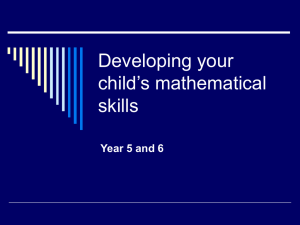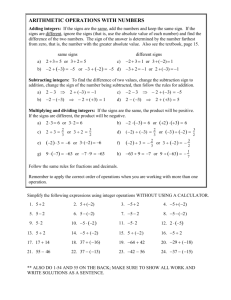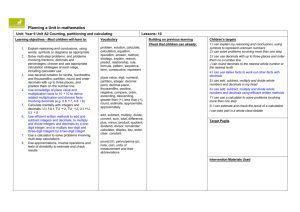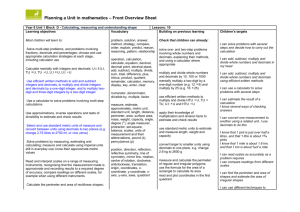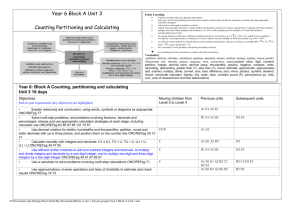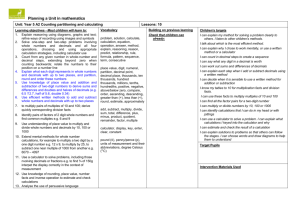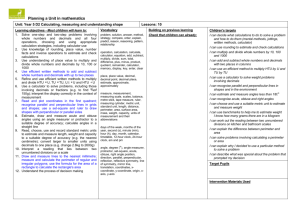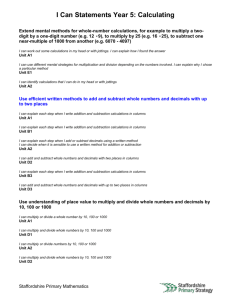YEAR 5 BLOCK A UNIT 1 (AUTUMN)
advertisement
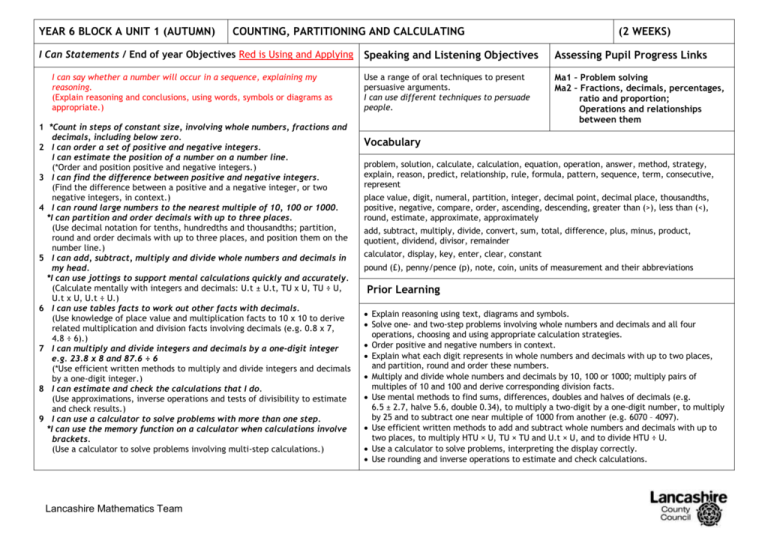
YEAR 6 BLOCK A UNIT 1 (AUTUMN) COUNTING, PARTITIONING AND CALCULATING I Can Statements / End of year Objectives Red is Using and Applying I can say whether a number will occur in a sequence, explaining my reasoning. (Explain reasoning and conclusions, using words, symbols or diagrams as appropriate.) 1 *Count in steps of constant size, involving whole numbers, fractions and decimals, including below zero. 2 I can order a set of positive and negative integers. I can estimate the position of a number on a number line. (*Order and position positive and negative integers.) 3 I can find the difference between positive and negative integers. (Find the difference between a positive and a negative integer, or two negative integers, in context.) 4 I can round large numbers to the nearest multiple of 10, 100 or 1000. *I can partition and order decimals with up to three places. (Use decimal notation for tenths, hundredths and thousandths; partition, round and order decimals with up to three places, and position them on the number line.) 5 I can add, subtract, multiply and divide whole numbers and decimals in my head. *I can use jottings to support mental calculations quickly and accurately. (Calculate mentally with integers and decimals: U.t ± U.t, TU x U, TU ÷ U, U.t x U, U.t ÷ U.) 6 I can use tables facts to work out other facts with decimals. (Use knowledge of place value and multiplication facts to 10 x 10 to derive related multiplication and division facts involving decimals (e.g. 0.8 x 7, 4.8 ÷ 6).) 7 I can multiply and divide integers and decimals by a one-digit integer e.g. 23.8 x 8 and 87.6 ÷ 6 (*Use efficient written methods to multiply and divide integers and decimals by a one-digit integer.) 8 I can estimate and check the calculations that I do. (Use approximations, inverse operations and tests of divisibility to estimate and check results.) 9 I can use a calculator to solve problems with more than one step. *I can use the memory function on a calculator when calculations involve brackets. (Use a calculator to solve problems involving multi-step calculations.) Lancashire Mathematics Team (2 WEEKS) Speaking and Listening Objectives Assessing Pupil Progress Links Use a range of oral techniques to present persuasive arguments. I can use different techniques to persuade people. Ma1 – Problem solving Ma2 – Fractions, decimals, percentages, ratio and proportion; Operations and relationships between them Vocabulary problem, solution, calculate, calculation, equation, operation, answer, method, strategy, explain, reason, predict, relationship, rule, formula, pattern, sequence, term, consecutive, represent place value, digit, numeral, partition, integer, decimal point, decimal place, thousandths, positive, negative, compare, order, ascending, descending, greater than (>), less than (<), round, estimate, approximate, approximately add, subtract, multiply, divide, convert, sum, total, difference, plus, minus, product, quotient, dividend, divisor, remainder calculator, display, key, enter, clear, constant pound (£), penny/pence (p), note, coin, units of measurement and their abbreviations Prior Learning Explain reasoning using text, diagrams and symbols. Solve one- and two-step problems involving whole numbers and decimals and all four operations, choosing and using appropriate calculation strategies. Order positive and negative numbers in context. Explain what each digit represents in whole numbers and decimals with up to two places, and partition, round and order these numbers. Multiply and divide whole numbers and decimals by 10, 100 or 1000; multiply pairs of multiples of 10 and 100 and derive corresponding division facts. Use mental methods to find sums, differences, doubles and halves of decimals (e.g. 6.5 ± 2.7, halve 5.6, double 0.34), to multiply a two-digit by a one-digit number, to multiply by 25 and to subtract one near multiple of 1000 from another (e.g. 6070 – 4097). Use efficient written methods to add and subtract whole numbers and decimals with up to two places, to multiply HTU × U, TU × TU and U.t × U, and to divide HTU ÷ U. Use a calculator to solve problems, interpreting the display correctly. Use rounding and inverse operations to estimate and check calculations.

